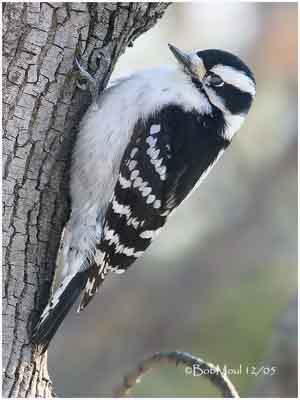
Downy Woodpecker
Picoides pubescens
Piciforme Order – Picidae Family
BIOMETRICS:
Length: 14 à 17 cm
Wingspan: 25 à 30 cm
Weight: 21 à 28 g
LONGEVITY: Up to 11 years
DESCRIPTION:
Downy Woodpecker is the smallest woodpecker of North America. It has black and white plumage, with white in the middle of the back, and also on breast and belly, where white becomes greyish.
Wings are black with white spots. Tail is black, with white outer feathers, and sometimes barred with black.
Head is black, and we can see a white stripe above and below eyes. It has whitish feathers above the bill, black cheeks, and thin black moustache extending to the neck and upper sides of breast.
Male has a small red patch on the rear crown.
Bill is thick, short, black and chisel-shaped, but smaller than other woodpeckers. Eyes are dark. Legs and feet are pale grey.
Female lacks red patch on head. She has black patch.
Juvenile male has red forehead, but lacks red patch on rear crown.
Juvenile female is similar, but lacks red.

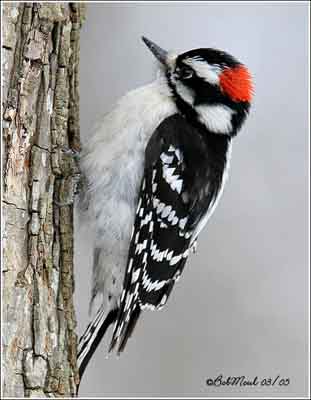
VOICE: SOUNDS BY XENO-CANTO
Downy Woodpecker has a wide variety of sounds. During aggressive behaviour, it utters “pik”, introducing rattle calls. Young birds utter short “wad” and “chirp” calls, and also a longer note, the squeak. We can also hear scolding, squeak, screech and distress calls.
Downy Woodpecker uses the drumming, a non vocal sound, to communicate.
HABITAT:
Downy Woodpecker lives in woodlands, deciduous forests in riparian areas. It is common in orchards, parks and urban areas.
RANGE:
Downy Woodpecker is found throughout North America. They are year round residents, except along the Atlantic Coasts where some populations are partially migratory.
BEHAVIOUR:
Downy Woodpecker uses body postures to communicate, such as combination of bill pointing and waving, flicking wings, raising crest, wings and tail spreading, head turning and swinging.
Drumming is used to establish territory, to attract a mate, and to communicate between them.
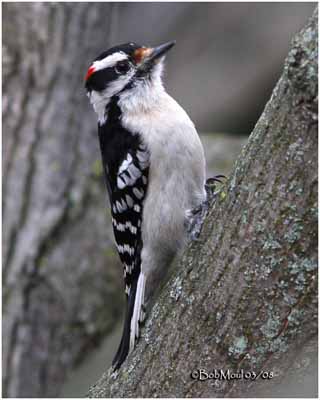
To feed, Downy Woodpecker gleans insects from tree-trunk, shrubs and large weeds. It also probes into crevices, or excavates holes into wood to find food. Downy Woodpecker is an acrobatic forager. It can hang upside down to feed.
It is a solitary diurnal bird, but sometimes, it forages in loose flocks.
Male defends a territory against males, and female against females. When an intruder comes into the territory, Downy Woodpecker performs threat displays, such as flicking wings, or fan-tailed display, with erected crest, and trying to drive the intruder away, holding their bill high. It may attack the intruder, grappling with them in mid-air.
Downy Woodpecker is monogamous. Once a pair is formed, they forage together until incubation begins. It is a form of mate guarding. They mate together for more than one breeding season.
To protect themselves from predators, Downy Woodpeckers flatten themselves against the tree bark, remaining motionless. It may also dodge a raptor, by darting behind a tree branch, or winding their way around a branch to avoid the hawk.
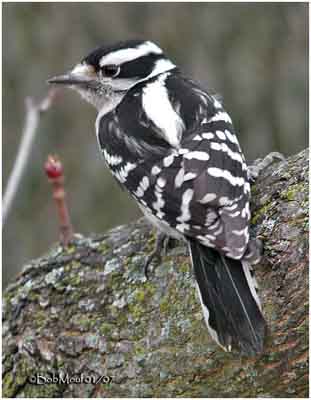
FLIGHT:
Downy Woodpecker performs glides and undulations when flying.
REPRODUCTION:
Downy Woodpecker’s nest is excavated by both male and female, in a dead climb, or a living or dead tree. This work lasts between one and three weeks. Nest is lined only with wood chips, and opening is concealed with mosses and lichens.
Female lays 3 to 8 white glossy eggs. Incubation lasts about 12 days, shared by both parents. Male incubates at night, and alternately with female during the day.
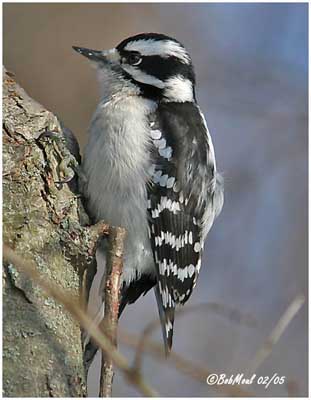
Chicks hatch altricial, but they grow very quickly. They are brooded during the first four days after hatching, and both adults feed them.
Young fledge at about 18 to 21 days of age. Parents feed them for at least three weeks more, and protect them against predators.
Young reach their sexual maturity at one year.
This species produces one single clutch per year.
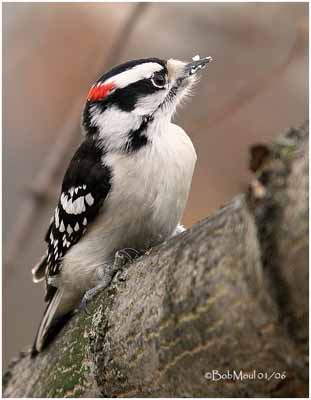
DIET:
Downy Woodpecker is omnivorous. It feeds mainly on insects (beetles, ants, bugs and caterpillars), but also arthropods, fruits, seeds and sap. It consumes also spiders and suet from feeders.
Males probes deep into the wood with its bill longer than this of female, which only pries under the bark.
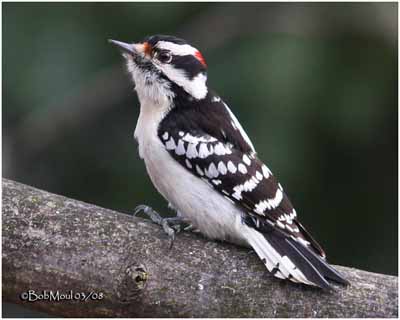
PROTECTION/ THREATS / STATUS:
Downy Woodpecker adults are preyed upon by birds of prey. In urban areas, their predators are rats and domestic cats. Eggs and nestlings are attacked by snakes and squirrels.
Downy Woodpecker populations are stable or increasing in some areas.
Fr: Pic mineur
All : Dunenspecht
Esp : Pico Pubescente
Ital : Picchio Vellutato
Nd : Donspecht
Sd : Dunspett
Photographs by Bob Moul
His website :
Nature Photography
Text by Nicole Bouglouan
Sources :
HANDBOOK OF THE BIRDS OF THE WORLD Vol. 7 by Josep del Hoyo-Andrew Elliott-Jordi Sargatal – Lynx Edicions – ISBN: 8487334377
FIELD GUIDE TO THE BIRDS OF NORTH AMERICA by National Geographic Society - National Geographic Society - ISBN: 0792274512
All About Birds (Cornell Lab of Ornithology)
Animal Diversity Web (University of Michigan Museum of Zoology)
What Bird-The ultimate Bird Guide (Mitchell Waite)
Wikipedia (Wikipedia, The Free Encyclopedia)
Bird Web (Seattle Audubon Society)